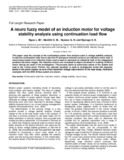| dc.contributor.author | Ngoo, L.M. | |
| dc.contributor.author | Muriithi, Christopher M. | |
| dc.contributor.author | Nyakoe, G.N | |
| dc.contributor.author | Njoroge, S.N | |
| dc.date.accessioned | 2017-09-01T13:03:02Z | |
| dc.date.available | 2017-09-01T13:03:02Z | |
| dc.date.issued | 2011 | |
| dc.identifier.citation | Journal of Electrical and Electronics Engineering Research Vol. 3(4), pp. 42-51, April 2011 | en_US |
| dc.identifier.issn | ISSN – 2141 – 2367 | |
| dc.identifier.uri | http://hdl.handle.net/123456789/2774 | |
| dc.identifier.uri | http://www.academicjournals.org/journal/JEEER/article-abstract/206A5239071 | |
| dc.description.abstract | This paper uses the concept of the continuation power flow analysis used in voltage stability analysis.It uses the continuation load flow to plot the PV (pressure-volume) curves of an induction motor load. A neuro-fuzzy model of an induction motor load is used to represent an industrial load. In the subsequent predictor-corrector stages, the induction motors are increased to depict increment in loading. Different motor ratings are used in the investigation. The process starts at some base values of the system and
lead to the critical point. Further, the reduced Jacobian is used to strategically locate the capacitor banks in the power system so as to effect maximum voltage improvement. In the case study, illustrative examples with the IEEE 30 bus system are shown. | en_US |
| dc.language.iso | en | en_US |
| dc.subject | Continuation load flow, | en_US |
| dc.subject | induction motors, | en_US |
| dc.subject | neuro-fuzzy. | en_US |
| dc.title | A neuro fuzzy model of an induction motor for voltage stability analysis using continuation load flow | en_US |
| dc.type | Article | en_US |

